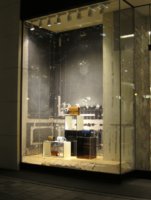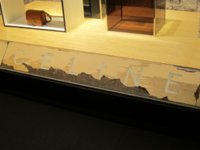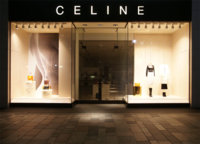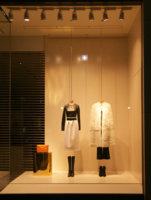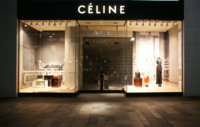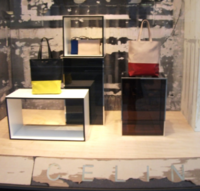You are using an out of date browser. It may not display this or other websites correctly.
You should upgrade or use an alternative browser.
You should upgrade or use an alternative browser.
CÉLINE Shop Interior Design and Ambience FAN CLUB
- Thread starter cotonblanc
- Start date
TPF may earn a commission from merchant affiliate
links, including eBay, Amazon, and others
More options
Who Replied?" The House that Céline built "
By ROBERT MURPHY
March 25, 2015 9:58 a.m. ET
ON PARISS TINY rue Vivienne, a stones throw from the Palais-Royal, the regal pile built by Cardinal Richelieu as his home nearly 400 years ago, sits a smaller yet equally stately neoclassical mansion known as the Hôtel Colbert de Torcy. Behind its limestone facade, the walls have witnessed their fair share of French history. Constructed in the mid-17th century, the building was originally owned by Jacques Tubeuf, a financial advisor to the absolutist King Louis XIII and a close confidant of Cardinal Jules Mazarin, the Machiavellian godfather to the Sun King, Louis XIV.
Today, fashion aristocracy has moved in. Céline, the influential LVMH-owned fashion and accessories brand, has made the hôtel particulier its first Parisian maison. An extensive gut-renovation was recently completed, transporting the space back to its former glory, under the direction of the discreet and finely attuned British creative director Phoebe Philo. Together with chief executive officer Marco Gobbetti, she has led the 70-year-old brand to new heights, with revenue increasing fourfold since their arrival in 2008. But Céline, which was founded in 1945 and became part of LVMH in 1996, didnt have a headquarters that matched the level of its influence. With its arrival at 16 rue Vivienne, it has finally joined the major houses whose addresses are part of Pariss fashion landscape, such as Chanel at 31 rue Cambon, Dior at 30 avenue Montaigne and Hermès at 24 rue du Faubourg Saint-Honoré.
Creative director Phoebe Philo ENLARGE
Creative director Phoebe Philo PHOTO: ZOË GHERTNER
This is home, basically, says Gobbetti, 56. Our project has been about building a house more than a brand. From that point of view, this building represents the foundation and where we come from. It is solid with an element of timelessness.
While he and Philo gravitated to the building for its history, they realized it would need a major overhaul to return it to its former glory. Its last incarnation as drab corporate offices concealed the buildings elegant bones. Only a few hints of its former self persisted, including a sweeping stone staircase, part of the original design by French architect Pierre Le Muet, as well as the Salle Colbert, a great room with ornately painted 19th-century wood paneling. (Its now a dining room where clients can enjoy lunch under the picturesque blue-and-white ceiling.) And though the structure itself is protected by order of the French culture ministry, nearly everything inside needed to be redone. Not only did the project provide ample room for the entire company, which had been divided in disparate locations across Paris, but it also offered the opportunity for Philo to carve the brands identity in solid stone.
I believe in things being beautifully made but at the same time practical, says Philo, 41, who directed the renovation herself rather than hiring a high-profile architect, as have many of her peers. We work in a detailed and thorough manner. I like the process to have an ease, allowing for things to unfold as we go along.
Like Philos designs for Célines fashion and accessories, the results avoid any overt branding. The only hint of the buildings stylish occupants is a discreet, creamy Céline sign next to the heavy entry doors painted a vibrant cerulean blue. In the sparsely decorated foyer across the cobblestone courtyard is a potted ficus tree, a signature of many Céline stores.
The hôtel is a beautiful historical container that stands on its own, but on the inside we wanted to innovate and do something different, says Gobbetti. Both Phoebe and I are interested in building something that will last over time.
In design terms, that meant juxtaposing the structures existing details like marble mantelpieces, painted wood beams and ornate moldings with clean white walls and brightly colored lacquered display cabinets. The main showroom features a multicolored marquetry floorsimilar to those in Célines stores in New Yorks SoHo and Londons Mount Streetincorporating 12 types of marble sourced from Italy, France and Brazil. Under the bright, nearly clinical lighting from custom-designed fixtures, the lush marble provides a rich counterpoint to the sleek ready-to-wear. Ultra-simple black racks vanish under the hanging clothes, and wooden boxes with rattan trim are arranged neatly as low display tables. The décor is situated somewhere between the postmodern baroque of Italian masters Ettore Sottsass and Piero Gilardi and mid-century modern functional austerity. Save for chairs by German architect Egon Eiermann and British designer Robin Day, as well as a few vintage finds, Philo oversaw all the furniture design, including the rough-hewn-wood stools and the simple white trestle display cases. In an elegant, round meeting room with parquet flooring, a UFO-like vintage Danish fixture lights a curvilinear, black vintage table, while in a reception space, an oversize brass chandelier from the Danish artist FOS (a.k.a. Thomas Poulsen) hovers overhead. (Philo also worked with FOS to create light fixtures and planters for the Céline stores.)
A neoclassical stairway at fashion brand Célines first Parisian maison on rue Vivienne. ENLARGE
A neoclassical stairway at fashion brand Célines first Parisian maison on rue Vivienne. PHOTO: ROBERT POLIDORI FOR WSJ. MAGAZINE
The building is austere, says Gobbetti. But on the inside you need to feel good. Central to the project is a vast design studio, visible through a glass atrium that resembles an orangery. Philos staff scurries about conferring with seamstresses and pattern-cutters in order to perfect her prototypes for the next show. In an unexpected note of the exotic, a low seagrass wall cuts through the space. Philo herself works in London, where she is based with her husband and their three children. Nearly every week, members of her design team zoom under the English Channel on the Eurostar to conduct fittings. (Philo also keeps an office on rue Vivienne for her regular visits.) Its an arrangement that works as fluidly as one of Célines long, ribbon-banded dresses.
WHEN PHILO WAS named creative director of Céline in September 2008, she seized on what she saw as the houses relatively clean slate. After some years of drifting following the departure of American designer Michael Kors in 2004, the brand seemed unburdened with weighty links to the past. (It was originally founded at the end of World War II as a childrens shoe boutique by Céline Vipiana, who subsequently began designing practical yet luxe separates and handbags for her adult clientele.) From Philos first collection in the spring of 2009, she proposed a chic aesthetic that resonated immediately for its utilitarian bent: a mens-style crewneck sweater in gray cashmere that is relaxed even further by subtle notches at the waist, a tailored black topcoat differentiated by rows of oversize white buttons, an unconstricting knit evening dress in textured silk with a heavily fringed hem.
Part of Philos success also stemmed from refusal: She deliberately shied away from overtly seasonal novelty, focusing, according to Gobbetti, on more enduring style. (Indeed, Céline issues similarly styled classic pieces each season, such as tuxedo shirts and Crombie coats.)
By ROBERT MURPHY
March 25, 2015 9:58 a.m. ET
ON PARISS TINY rue Vivienne, a stones throw from the Palais-Royal, the regal pile built by Cardinal Richelieu as his home nearly 400 years ago, sits a smaller yet equally stately neoclassical mansion known as the Hôtel Colbert de Torcy. Behind its limestone facade, the walls have witnessed their fair share of French history. Constructed in the mid-17th century, the building was originally owned by Jacques Tubeuf, a financial advisor to the absolutist King Louis XIII and a close confidant of Cardinal Jules Mazarin, the Machiavellian godfather to the Sun King, Louis XIV.
Today, fashion aristocracy has moved in. Céline, the influential LVMH-owned fashion and accessories brand, has made the hôtel particulier its first Parisian maison. An extensive gut-renovation was recently completed, transporting the space back to its former glory, under the direction of the discreet and finely attuned British creative director Phoebe Philo. Together with chief executive officer Marco Gobbetti, she has led the 70-year-old brand to new heights, with revenue increasing fourfold since their arrival in 2008. But Céline, which was founded in 1945 and became part of LVMH in 1996, didnt have a headquarters that matched the level of its influence. With its arrival at 16 rue Vivienne, it has finally joined the major houses whose addresses are part of Pariss fashion landscape, such as Chanel at 31 rue Cambon, Dior at 30 avenue Montaigne and Hermès at 24 rue du Faubourg Saint-Honoré.
Creative director Phoebe Philo ENLARGE
Creative director Phoebe Philo PHOTO: ZOË GHERTNER
This is home, basically, says Gobbetti, 56. Our project has been about building a house more than a brand. From that point of view, this building represents the foundation and where we come from. It is solid with an element of timelessness.
While he and Philo gravitated to the building for its history, they realized it would need a major overhaul to return it to its former glory. Its last incarnation as drab corporate offices concealed the buildings elegant bones. Only a few hints of its former self persisted, including a sweeping stone staircase, part of the original design by French architect Pierre Le Muet, as well as the Salle Colbert, a great room with ornately painted 19th-century wood paneling. (Its now a dining room where clients can enjoy lunch under the picturesque blue-and-white ceiling.) And though the structure itself is protected by order of the French culture ministry, nearly everything inside needed to be redone. Not only did the project provide ample room for the entire company, which had been divided in disparate locations across Paris, but it also offered the opportunity for Philo to carve the brands identity in solid stone.
I believe in things being beautifully made but at the same time practical, says Philo, 41, who directed the renovation herself rather than hiring a high-profile architect, as have many of her peers. We work in a detailed and thorough manner. I like the process to have an ease, allowing for things to unfold as we go along.
Like Philos designs for Célines fashion and accessories, the results avoid any overt branding. The only hint of the buildings stylish occupants is a discreet, creamy Céline sign next to the heavy entry doors painted a vibrant cerulean blue. In the sparsely decorated foyer across the cobblestone courtyard is a potted ficus tree, a signature of many Céline stores.
The hôtel is a beautiful historical container that stands on its own, but on the inside we wanted to innovate and do something different, says Gobbetti. Both Phoebe and I are interested in building something that will last over time.
In design terms, that meant juxtaposing the structures existing details like marble mantelpieces, painted wood beams and ornate moldings with clean white walls and brightly colored lacquered display cabinets. The main showroom features a multicolored marquetry floorsimilar to those in Célines stores in New Yorks SoHo and Londons Mount Streetincorporating 12 types of marble sourced from Italy, France and Brazil. Under the bright, nearly clinical lighting from custom-designed fixtures, the lush marble provides a rich counterpoint to the sleek ready-to-wear. Ultra-simple black racks vanish under the hanging clothes, and wooden boxes with rattan trim are arranged neatly as low display tables. The décor is situated somewhere between the postmodern baroque of Italian masters Ettore Sottsass and Piero Gilardi and mid-century modern functional austerity. Save for chairs by German architect Egon Eiermann and British designer Robin Day, as well as a few vintage finds, Philo oversaw all the furniture design, including the rough-hewn-wood stools and the simple white trestle display cases. In an elegant, round meeting room with parquet flooring, a UFO-like vintage Danish fixture lights a curvilinear, black vintage table, while in a reception space, an oversize brass chandelier from the Danish artist FOS (a.k.a. Thomas Poulsen) hovers overhead. (Philo also worked with FOS to create light fixtures and planters for the Céline stores.)
A neoclassical stairway at fashion brand Célines first Parisian maison on rue Vivienne. ENLARGE
A neoclassical stairway at fashion brand Célines first Parisian maison on rue Vivienne. PHOTO: ROBERT POLIDORI FOR WSJ. MAGAZINE
The building is austere, says Gobbetti. But on the inside you need to feel good. Central to the project is a vast design studio, visible through a glass atrium that resembles an orangery. Philos staff scurries about conferring with seamstresses and pattern-cutters in order to perfect her prototypes for the next show. In an unexpected note of the exotic, a low seagrass wall cuts through the space. Philo herself works in London, where she is based with her husband and their three children. Nearly every week, members of her design team zoom under the English Channel on the Eurostar to conduct fittings. (Philo also keeps an office on rue Vivienne for her regular visits.) Its an arrangement that works as fluidly as one of Célines long, ribbon-banded dresses.
WHEN PHILO WAS named creative director of Céline in September 2008, she seized on what she saw as the houses relatively clean slate. After some years of drifting following the departure of American designer Michael Kors in 2004, the brand seemed unburdened with weighty links to the past. (It was originally founded at the end of World War II as a childrens shoe boutique by Céline Vipiana, who subsequently began designing practical yet luxe separates and handbags for her adult clientele.) From Philos first collection in the spring of 2009, she proposed a chic aesthetic that resonated immediately for its utilitarian bent: a mens-style crewneck sweater in gray cashmere that is relaxed even further by subtle notches at the waist, a tailored black topcoat differentiated by rows of oversize white buttons, an unconstricting knit evening dress in textured silk with a heavily fringed hem.
Part of Philos success also stemmed from refusal: She deliberately shied away from overtly seasonal novelty, focusing, according to Gobbetti, on more enduring style. (Indeed, Céline issues similarly styled classic pieces each season, such as tuxedo shirts and Crombie coats.)
We are a counterpoint, says Gobbetti. The timing of our project coincided with the peak of very disposable fashion, so Céline was a bit of a page-turner. We went back to basics with clothes that were meant to last. He continues, “Céline is a brand for women and designed by a woman, not a mans fantasy of women.
I believe in things being beautifully made but at the same time practical
Phoebe Philo
Gobbetti has a knack for interacting with creative types. Before Céline, he headed Givenchy, also part of LVMH, where he worked alongside the Italian designer Riccardo Tisci, known for his dramatic flights of fashion fantasy. Tiscis exuberance is just as potent as Philos restraint. Gobbetti says the secret to his relationship with Philo lies in clarity. It is predicated on sharing goals and making things clear from the beginning. There is a lot of sharing. I can get a lot of inspiration from Phoebe and vice versa.
For her part, Philo says, We have a relationship based on clearly defined responsibilities and on mutual respect.
Philo has shunned the role of designer as an oracle pronouncing from a fashion Olympus. She frequently declines interviews, preferring to have her designs say it all, which is not surprising from a woman who stepped away from fashion in 2006when she was at the height of her influence as the designer of Chloéto focus on her private life. Maintaining her home base in London is a deliberate part of this effort.
LIGHT WORK | The Paris-based design team takes the Eurostar to conduct near-weekly fittings in London, where Philo is based. ENLARGE
LIGHT WORK | The Paris-based design team takes the Eurostar to conduct near-weekly fittings in London, where Philo is based. PHOTO: ROBERT POLIDORI FOR WSJ. MAGAZINE
The advantage of having [her] studio in London is that it keeps a bit of distance between Phoebe and Paris, says Gobbetti. It prevents the brand from becoming too bourgeois. We have this London street inspiration that is very good nourishment for Céline.
Instead of courting Hollywood, Céline has sought out esoteric partnerships, sponsoring the 201314 retrospective at New Yorks Museum of Modern Art of German sculptor Isa Genzken, an artist revered by insiders but an enigma to most. Even the brands advertisements, photographed by Juergen Teller, appear to echo that stance. After several seasons of featuring the model Daria Werbowy as a sort of proxy for Philo, this seasons campaign includes the 80-year-old author Joan Didion. And in similar spirit, Céline does not have an official Instagram or Twitter feed.
I feel fashion has overcrowded and has made a lot of noise on the Internet, Gobbetti says. I think that being quiet gives more value to what we do. He adds that Célines softer approach has informed the brands strategy of distribution: Since he and Philo arrived, they have closed more stores than they have opened, going from 115 in 2008 to 94 today.
The stores we closed did not reflect our standards, says Gobbetti. We evaluated every space and what it meant for the brand. Some did not make sense for us now.
Nor does he want to participate in the burgeoning sector of luxury e-commerce, where brands like Valentino and Saint Laurent have enthusiastically forged ahead. We think it is important to touch the clothesmuch of what is special is lost on e-commerce, he says. We want to control what we do. We control from the design and the production. If we make mistakes they are our own.
Despite the rapid success of Céline, Gobbetti emphasizes that his goal is to not grow too quickly. We want to be specialized: We only do four categories or products: ready-to-wear, shoes, bags and costume jewelry, says Gobbetti. I dont expect Céline to have 400 stores. Thats not our path.
Thats not to say that growth is not his focus. He sees the United States, in particular, representing fertile soil for the brand. Céline is now a value that customers turn to, which is a big accomplishment over a short period of time, he says. He surveys the gracefully classic proportions of the brands new space before offering the simplest assessment of what drives him and Philo. At the center of our project is the goal of making things, says Gobbetti. Very beautiful things women want to buy.
I believe in things being beautifully made but at the same time practical
Phoebe Philo
Gobbetti has a knack for interacting with creative types. Before Céline, he headed Givenchy, also part of LVMH, where he worked alongside the Italian designer Riccardo Tisci, known for his dramatic flights of fashion fantasy. Tiscis exuberance is just as potent as Philos restraint. Gobbetti says the secret to his relationship with Philo lies in clarity. It is predicated on sharing goals and making things clear from the beginning. There is a lot of sharing. I can get a lot of inspiration from Phoebe and vice versa.
For her part, Philo says, We have a relationship based on clearly defined responsibilities and on mutual respect.
Philo has shunned the role of designer as an oracle pronouncing from a fashion Olympus. She frequently declines interviews, preferring to have her designs say it all, which is not surprising from a woman who stepped away from fashion in 2006when she was at the height of her influence as the designer of Chloéto focus on her private life. Maintaining her home base in London is a deliberate part of this effort.
LIGHT WORK | The Paris-based design team takes the Eurostar to conduct near-weekly fittings in London, where Philo is based. ENLARGE
LIGHT WORK | The Paris-based design team takes the Eurostar to conduct near-weekly fittings in London, where Philo is based. PHOTO: ROBERT POLIDORI FOR WSJ. MAGAZINE
The advantage of having [her] studio in London is that it keeps a bit of distance between Phoebe and Paris, says Gobbetti. It prevents the brand from becoming too bourgeois. We have this London street inspiration that is very good nourishment for Céline.
Instead of courting Hollywood, Céline has sought out esoteric partnerships, sponsoring the 201314 retrospective at New Yorks Museum of Modern Art of German sculptor Isa Genzken, an artist revered by insiders but an enigma to most. Even the brands advertisements, photographed by Juergen Teller, appear to echo that stance. After several seasons of featuring the model Daria Werbowy as a sort of proxy for Philo, this seasons campaign includes the 80-year-old author Joan Didion. And in similar spirit, Céline does not have an official Instagram or Twitter feed.
I feel fashion has overcrowded and has made a lot of noise on the Internet, Gobbetti says. I think that being quiet gives more value to what we do. He adds that Célines softer approach has informed the brands strategy of distribution: Since he and Philo arrived, they have closed more stores than they have opened, going from 115 in 2008 to 94 today.
The stores we closed did not reflect our standards, says Gobbetti. We evaluated every space and what it meant for the brand. Some did not make sense for us now.
Nor does he want to participate in the burgeoning sector of luxury e-commerce, where brands like Valentino and Saint Laurent have enthusiastically forged ahead. We think it is important to touch the clothesmuch of what is special is lost on e-commerce, he says. We want to control what we do. We control from the design and the production. If we make mistakes they are our own.
Despite the rapid success of Céline, Gobbetti emphasizes that his goal is to not grow too quickly. We want to be specialized: We only do four categories or products: ready-to-wear, shoes, bags and costume jewelry, says Gobbetti. I dont expect Céline to have 400 stores. Thats not our path.
Thats not to say that growth is not his focus. He sees the United States, in particular, representing fertile soil for the brand. Céline is now a value that customers turn to, which is a big accomplishment over a short period of time, he says. He surveys the gracefully classic proportions of the brands new space before offering the simplest assessment of what drives him and Philo. At the center of our project is the goal of making things, says Gobbetti. Very beautiful things women want to buy.
Register on TPF! This sidebar then disappears and there are less ads!



